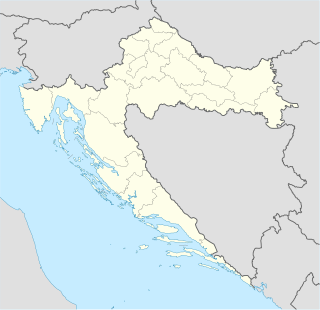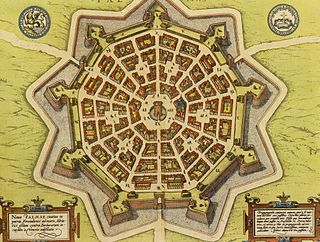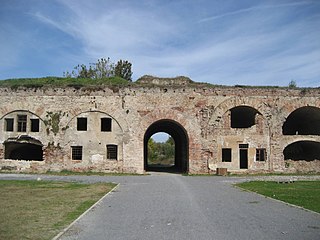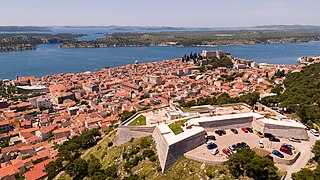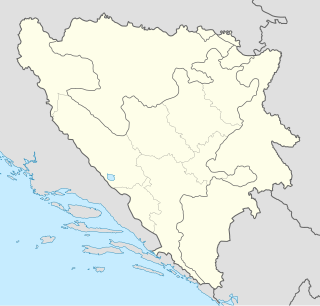| Starigrad Fortress (Fortica) | |
|---|---|
| Tvrđava Starigrad-Fortica | |
| Omiš Croatia | |
 Starigrad Fortress (Fortica) in Omiš | |
| Coordinates | 43°26′41″N16°42′0″E / 43.44472°N 16.70000°E Coordinates: 43°26′41″N16°42′0″E / 43.44472°N 16.70000°E |
| Height | about 262 metres (860 ft) |
| Site history | |
| Built | 15th century |
| Built by | Kingdom of Croatia |
| Materials | limestone |
Starigrad Fortress is a 15th century fortress located near Omiš in Split-Dalmatia county, in Dalmatia, Croatia. [1]
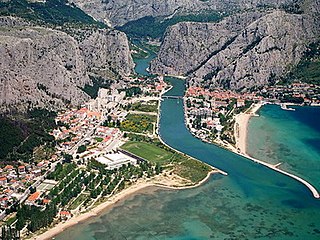
Omiš is a town and port in the Dalmatia region of Croatia, and is a municipality in the Split-Dalmatia County. The town is situated approximately 25 kilometres south-east of Croatia's second largest city, Split. Its location is where the Cetina River meets the Adriatic Sea. Omiš municipality has a population of 14,936 and its area is 266 square kilometres (103 sq mi).

Dalmatia is one of the four historical regions of Croatia, alongside Croatia proper, Slavonia and Istria.

Croatia, officially the Republic of Croatia is a country at the crossroads of Central and Southeast Europe, on the Adriatic Sea. It borders Slovenia to the northwest, Hungary to the northeast, Serbia to the east, Bosnia and Herzegovina, and Montenegro to the southeast, sharing a maritime border with Italy. Its capital, Zagreb, forms one of the country's primary subdivisions, along with twenty counties. Croatia has an area of 56,594 square kilometres and a population of 4.28 million, most of whom are Roman Catholics.


The fortress or Fortica was built during the Croatian–Ottoman wars as a primary defence against the Ottoman Empire. The precipitous fortification is sited on a 262 m (860 ft) ridge above the town Omiš. In the event of attack, its purpose was to provide refuge for local people and be a stronghold where they could retreat to and resist the Turks.
Croatian–Ottoman Wars can refer to one of the several conflicts between the Kingdom of Croatia and the Ottoman Empire:

The Ottoman Empire, also historically known in Western Europe as the Turkish Empire or simply Turkey, was a state that controlled much of Southeast Europe, Western Asia and North Africa between the 14th and early 20th centuries. It was founded at the end of the 13th century in northwestern Anatolia in the town of Söğüt by the Oghuz Turkish tribal leader Osman I. After 1354, the Ottomans crossed into Europe, and with the conquest of the Balkans, the Ottoman beylik was transformed into a transcontinental empire. The Ottomans ended the Byzantine Empire with the 1453 conquest of Constantinople by Mehmed the Conqueror.
As the stone fort's defensive strength is derived from the elevation at which it was built, it is a rudimentary defensive structure. A two-storey square tower stands at its highest point, serving as both a lookout post and keep. A simple bastion stands at the opposite end of the fort to cover the approach path and the ridge line. It has an outer barbican to defend the fort's narrow entrance gateway and the gorge below the fort. The walls, which are about 1 m (3 ft 3 in) thick, are made from locally quarried limestone. They enclose an inner bailey that is separated into two distinct levels by the difference in the site's natural rock height. Access between the levels is via a small stone stairway that was once protected by a stone wall and gateway. In event of attack, the fortification’s design permits the defenders to fall back to higher ground as each level falls.

A keep is a type of fortified tower built within castles during the Middle Ages by European nobility. Scholars have debated the scope of the word keep, but usually consider it to refer to large towers in castles that were fortified residences, used as a refuge of last resort should the rest of the castle fall to an adversary. The first keeps were made of timber and formed a key part of the Motte-and-Bailey castles that emerged in Normandy and Anjou during the 10th century; the design spread to England as a result of the Norman invasion of 1066, and in turn spread into Wales during the second half of the 11th century and into Ireland in the 1170s. The Anglo-Normans and French rulers began to build stone keeps during the 10th and 11th centuries; these included Norman keeps, with a square or rectangular design, and circular shell keeps. Stone keeps carried considerable political as well as military importance and could take up to a decade or more to build.

A bastion or bulwark is a structure projecting outward from the curtain wall of a fortification, most commonly angular in shape and positioned at the corners. The fully developed bastion consists of two faces and two flanks with fire from the flanks being able to protect the curtain wall and also the adjacent bastions. It is one element in the style of fortification dominant from the mid 16th to mid 19th centuries. Bastion fortifications offered a greater degree of passive resistance and more scope for ranged defense in the age of gunpowder artillery compared with the medieval fortifications they replaced.

A barbican is a fortified outpost or gateway, such as an outer defence to a city or castle, or any tower situated over a gate or bridge which was used for defensive purposes.


